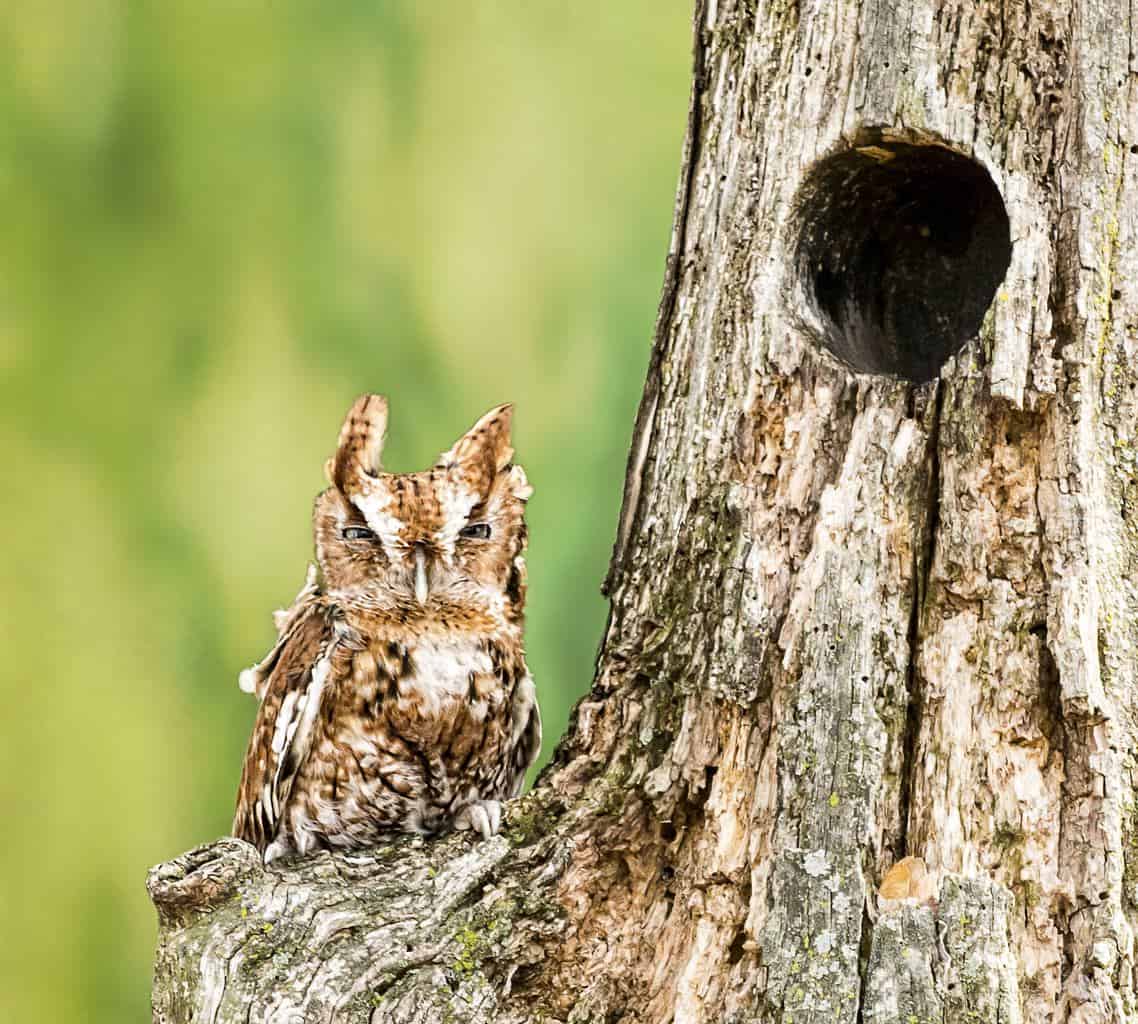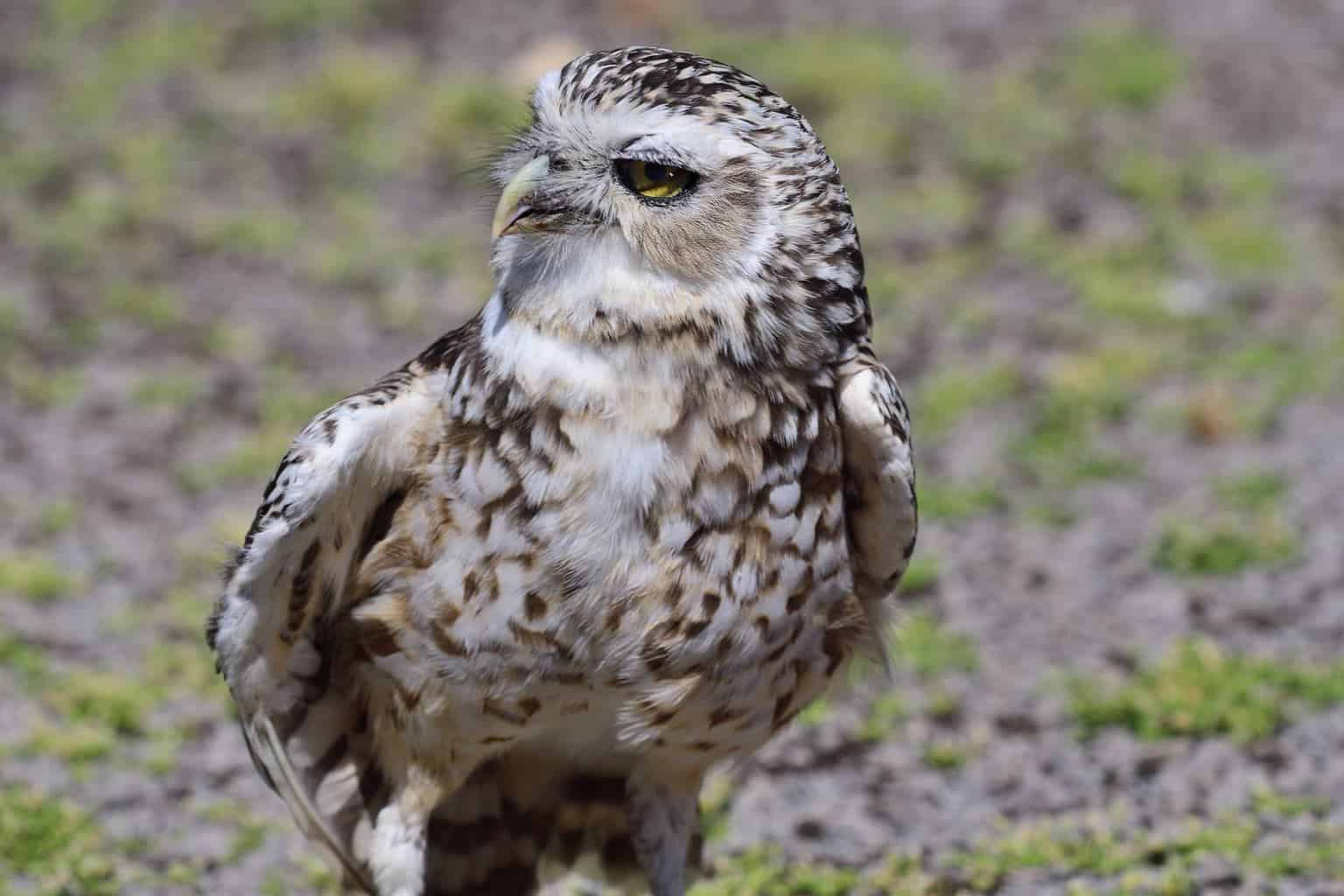In addition to being home to one of the largest U.S. cities, the state of New York is also home to a huge variety of birds that spread all the way from the Hudson River to the Great Lakes, hitting all the parks and forests in between!
As of 2021, there are 496 species of birds, according to the official checklist of the state of New York. The checklist includes 12 different species of owls, and we’re going to introduce you to each species of these wise and beautiful birds. Let’s dive in!
Great Horned Owl

- Scientific Name: Bubo virginianus-
- Length: 18.1-24.8 inches
- Weight: 32.1-88.2 ounces
- Wingspan: 39.8-57.1 inches
Kicking off our list is one of the most popular owls in North America: the great horned owl. It’s also known as a hoot owl because of its well-known call. Another nickname of this bird is the tiger owl, as it has an orangey face with black and white lines that look like a tiger’s stripes.
The great horned owl’s striking eyes and prominent ear tufts that add to its fierce predator persona are part of what makes this bird popular.
This species is the major nocturnal raptor in New York, preying on anything from small mice to large squirrels. It’s also one of the most well-adapted raptors to live alongside humans, so you can easily spot them near forests and lurking around feeders.
Short-Eared Owl

- Scientific Name: Asio flammeus
- Length: 13.4-16.9 inches
- Weight: 7.3-16.8 ounces
- Wingspan: 33.5-40.5 inches
The striking similarities between the long and short-eared owl species are, of course, why the two birds carry a name that’s almost the same.
While both of these owls are medium-sized with rounded heads, short-eared owls have shorter ear-like tufts of feathers. In fact, they’re so short, they’re practically invisible.
Short-eared owls also have brown backs with white and beige mottling on their upperparts. Look for their whitish faces, yellow eyes, and dark-accented edges.
Eastern Screech-Owl

- Scientific Name: Megascops asio
- Length: 6.3-9.8 inches
- Weight: 4.3-8.6 ounces
- Wingspan: 18.9-24.0 inches
The eastern screech-owl is a small bird that has a variety of markings and patterns. In New York, the bird occurs in two color varieties: one with reddish-brown feathers and the other with grey.
Despite being a strictly nocturnal bird, these screech-owls are highly adapted to living around urban and suburban areas.
One of their most prominent features is their ear-like tufts of feathers. However, they don’t actually use these for hearing, as the eastern screech-owls’ ears are actually below the tuft. Instead, they use these feathers for communication and threatening competitors.
Long-Eared Owl

- Scientific Name: Asio otus
- Length: 13.8-15.8 inches
- Weight: 7.8-15.3 ounces
- Wingspan: 35.4-39.4 inches
You’ll recognize long-eared owls by their remarkably long ear tufts, especially when compared to the size of their heads. They also sport oval heads, distinctive yellow facial disks, and a white X between their eyes.
The secretive and nocturnal long-eared owl may be difficult to spot, but a good way to find them in the grassland or open country in which they love to forage is to listen for their long and low hoots.
Barn Owl

- Scientific Name: Tyto alba
- Length: 12.6-15.8 inches
- Weight: 14.1-24.7 ounces
- Wingspan: 39.4-49.2 inches
If ever there was an owl in New York you would have no trouble identifying, it would be the American barn owl.
Commonly known as the monkey-faced or ghost owl, these birds have extremely unique facial features that set them apart from other owls. They’re also known for their silence when flying, long legs, extremely white faces, and lack of ear tufts.
Despite being easy to identify, barn owls are quite difficult to spot outside the cover of nightfall because they’re notably nocturnal. To find them, you’ll need to look around areas with plenty of old barns and tree cavities.
Snowy Owl

- Scientific Name: Bubo scandiacus
- Length: 20.5-27.9 inches
- Weight: 56.4-104.1 ounces
- Wingspan: 49.6-57.1 inches
New York is a popular haven for a large population of snowy owls. These relatively large birds have thick feathers on their round heads and have no ear tufts.
Usually, snowy owls perch on fence posts and telephone poles and have a relatively tolerant temper around humans.
Their most distinctive features are their sharp yellow eyes and pure white feathers, but sometimes, you’ll find a few snowy owls that have black marks or mottling on their wings.
Northern Saw-Whet Owl

- Scientific Name: Aegolius acadicus
- Length: 7.1-8.3 inches
- Weight: 2.3-5.3 ounces
- Wingspan: 16.5-18.9 inches
The northern saw-whet owl is one of the smallest owl species in New York and North America as a whole.
This tiny and elusive bird is known for its relatively loud call. Follow the sound of these birds to densely vegetated areas; you’ll probably find them there. You’ll recognize the northern saw-whet owl by its small brown body, white and black mottled face, and undefined facial disk.
Barred Owl

- Scientific Name: Strix varias
- Length: 16.9-19.7 inches
- Weight: 16.6-37.0 ounces
- Wingspan: 39.0-43.3 inches
Barred owls are among the species of owls who spend their breeding season in New York. They get their name from the horizontal bars on their tails, backs, and wings that alternate from light to dark brown.
Other unique features of this bird are its heart-shaped facial disk similar to that of the barn owl and reddish-brown body markings that resemble the great horned owl.
Boreal Owl

- Scientific Name: Aegolius funereus
- Length: 8.3-11.0 inches
- Weight: 3.3-7.6 ounces
- Wingspan: 21.6-24.4 inches
Boreal owls are also a well-known New York owl species. However, it’s not that easy to spot them throughout the state because they’re more distributed in the northern part of the state and generally rare in other regions.
The small raptors have big heads and tiny ear tufts, and they also have tiny white mottling across their facial disks that make them easy to find.
Great Grey Owl

- Scientific Name: Strix nebulosa
- Length: 24.0-33.1 inches
- Weight: 24.7-60.0 ounces
- Wingspan: 53.9-60.2 inches
The great grey owl has yellow-colored eyes with a whitish “X” on its face. Combine that with the bird’s iconic facial disks, and you’ll find that the great grey owl can’t be mistaken for any other bird.
You’ll most likely stumble across the great grey owl by accident, as they’re extremely rare in New York; they typically prefer the weather in the northwestern United States over that of the northeast.
Burrowing Owl

- Scientific Name: Athene cunicularis
- Length: 7.5-9.8 inches
- Weight: 5.3 ounces
- Wingspan: 21.6 inches
Burrowing owls prefer to make their homes in the western parts of the United States instead of the eastern areas. However, reports of the owl’s presence in New York have made it one of the state’s 12 species of owls.
These birds are among the handful of the world’s owls that aren’t nocturnal, as they’re most active during the daytime hours.
The burrowing owl has brown mottled feathers, deep yellow eyes, long legs, short tails, and tuftless round heads.
Northern Hawk-Owl

- Scientific Name: Surnia ulula
- Length: 14.2-17.7 inches
- Weight: 8.5-16.0 ounces
- Wingspan: 27.9 inches
Last but certainly not least is the northern hawk-owl, a medium-sized bird that has an oval-shaped body and a long and pointed tail.
You’ll mainly find this species in coniferous forests around New York in the wintertime, where they come to escape the north’s cold temperatures.
Much like the burrowing owl, northern hawk-owls are among the few owls that are mainly active during the day but will occasionally extend their active time into the night.
Wrap Up
Now you’ve met all 12 species of owls in New York State! If owls are your thing, you’ll certainly enjoy birdwatching in the Empire State. So, pack your binoculars, grab a field guide, and lace up those hiking boots; it’s time for a birdwatching adventure!

